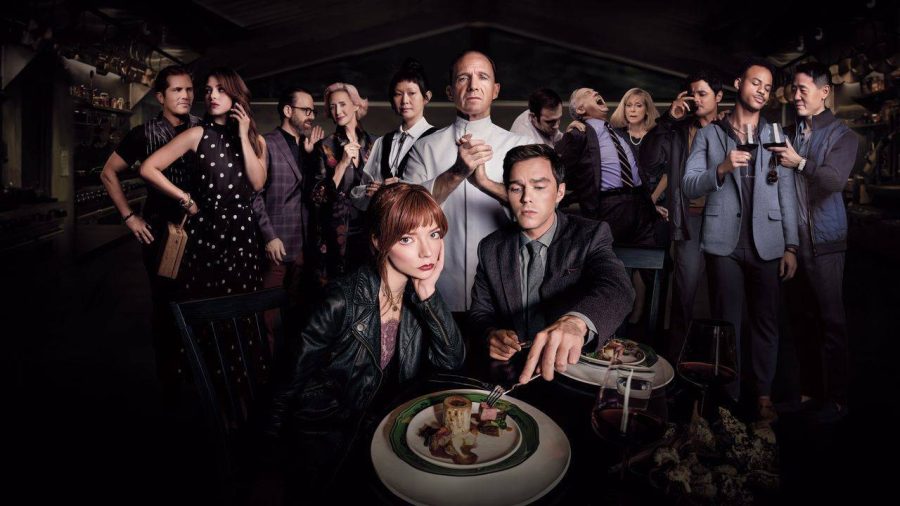Lee: ‘Menu’ leaves a lousy aftertaste
HBO’s “The Menu” shocks viewers with horror twists but leaves them with an unsatisfying aftertaste.
March 9, 2023
Since the invention of the motion picture, filmmakers have sought to explore the dark side of the artistic process. This is an apparent thematic trend in classic cinema — films like “Sunset Boulevard,” “The Red Shoes” and “8 1/2” all attempt to answer the at times gruesome question: What happens when an artist becomes too engrossed in their art?
This traditional fascination bleeds into contemporary filmmaking as well. Throughout the last couple decades, a myriad of films, such as “Whiplash,” “Black Swan” and “Birdman,” have tried their hands at portraying obsessed artist figures. However, the brushes these obsessed artists paint with have been notoriously limited in scope. Only the most culturally mainstream of the arts have been represented in these films, such as directing, dancing, music and acting. Never before has the trope been executed in which its primary figure wields a sharpened-steel knife and chef’s apron.
“The Menu,” at first glance, seems like a film set on shattering this trend.
The film’s execution of this concept, however, sorely lacks enough ingenuity to garner even a quarter of a Michelin star. It follows an assemblage of flat, satirical-for-the-sake-of-satire characters through an extravagant tasting menu on a nondescript modernist private island.
Rising star Anya Taylor-Joy, reprising her iconic red hair and accounting for a solid 80% of this film’s popularity, plays Margot, an ordinary girl whose new food-fanatic boyfriend decides to plus-one her on an expensive fine dining experience. She’s clearly supposed to be the audience’s emissary through the superficial world of expensive cuisine, but her character is so blatantly type-written and trite that the normalcy she appeals to is out of touch with the ordinary viewer.
Particularly egregious, too, is this film’s portrayal of fine dining as an artform. “The Menu” depicts the world of high cuisine as superficial and limited to the wealthy. While this point of criticism is at times merited, the film fails to portray fine dining as anything but a cesspool of needless extravagance. Through its harsh criticisms toward upscale restaurants, “The Menu” neglects to represent thoughtful cuisine in any sort of constructive light. And if you are deriding an artform as insignificant or facetious to major audiences, then it reasonably follows that many in the general culture will ignorantly write it off. In this way, “The Menu”’s cursory stance on fine dining is not only mindlessly shallow, but potentially harmful to appreciators of art everywhere.
Despite this film’s conceptual shortcomings, there are certain positive things that can be said about it. The film is incredibly creative, and the screenplay takes many unexpected, wildly fun turns. The production design and cinematography, though uniformly sharp and corporate, match the film’s slight atmosphere of pretentiousness. Ralph Fiennes gives an enjoyable performance as the central restaurant’s head chef — or alternatively its patron disillusioned artist. “The Menu” covers his theme of obsession in a fascinating way, portraying Fiennes’ character as a husband in a loveless marriage with fine dining. He has lost his once-vivid love for creation, and the film’s narrative serves to flesh out the relationship’s fiery deterioration to divorce.
“The Menu,” as simple entertainment, excels; however, when you pick it apart, analyze it and critique it, the film loses any meaningful sense of eloquence. In this way, “The Menu” is like a refreshing soda. At times, a soda is perfectly satisfying. Its taste is familiar, desirable and uncluttered, but when held against fine-aged wine, its excellence quickly fades. No matter how hard Coke wishes to be chardonnay, it never will be.
That all being said, “The Menu” is far from one of the worst films to come out this year. Regrettably, though, it stands as one of the most forgettable. The film invokes some clever cheap thrills, but it is scarcely anything beyond shocking, despite pervasive attempts to masquerade itself as utmost. “The Menu” is at its best when entirely unhinged — when the screenplay is absurd and stuffs its mouth with all sorts of decadent jokes and twists. These entertaining feasts arise only in isolated courses, though, and the rest of the film leaves the viewer with a lousy, half-baked aftertaste.









